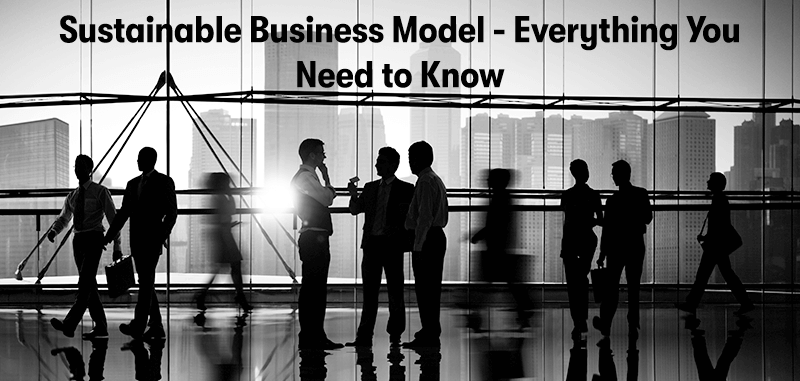Sustainable Business Model - Everything You Need to Know
Welcome to our insightful exploration of Sustainable Business Models – a paradigm shift in the world of business that intertwines profitability with environmental stewardship and social responsibility. In an era where the impact of businesses extends far beyond their financial bottom lines, adopting a sustainable approach has become imperative.
This concept is not just a trend; it's a comprehensive strategy ensuring companies thrive while positively contributing to the world. From reducing carbon footprints to enhancing community well-being and driving economic growth, sustainable business models are redefining success.
Join us as we delve into the core of what makes a business model sustainable, exploring its significance, benefits, and practical implementation in today's dynamic business landscape.
What is a Sustainable Business Model?
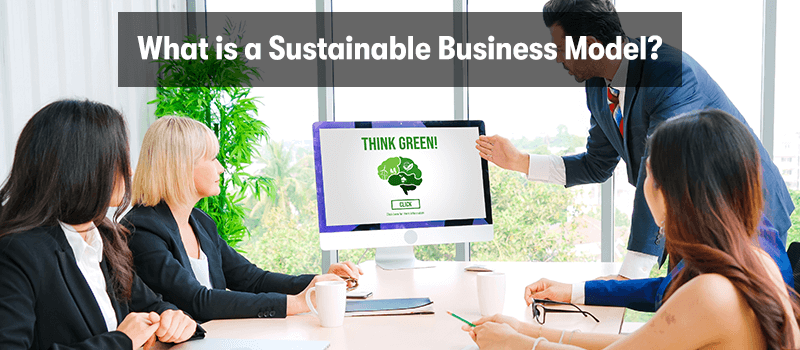
A sustainable business model refers to a way of doing business that not only generates profits but also creates value for society, the economy, and the environment over the long term. This model is grounded in the principles of sustainability, which emphasise the importance of balancing economic growth with the need for environmental protection and social equity. Here are some key characteristics of a sustainable business model:
Environmental Responsibility
Sustainable businesses prioritise reducing their environmental impact. This can include minimising waste, using renewable energy sources, implementing energy-efficient operations, and reducing carbon footprints.
Social Equity and Ethics
These businesses often focus on fair labour practices, community engagement, and contributing positively to society. They might invest in community projects, ensure fair wages and working conditions, and engage in ethical sourcing of materials.
Economic Viability
While focusing on social and environmental goals, sustainable businesses must also be economically viable. This means generating enough revenue to cover costs, invest in growth, and provide returns to stakeholders while also investing in sustainable practices.
Long-Term Perspective
Sustainable businesses often take a long-term view, focusing on enduring success rather than short-term gains. This involves planning and investing in ways that will ensure the business's viability and relevance in the future, considering emerging environmental and social trends.
Innovation and Adaptability
To remain sustainable, businesses must be innovative and adapt to changes in the market, technology, and regulatory environments. This could include developing new products and services that meet sustainability criteria or adopting new business processes that are more efficient and less harmful to the environment.
Stakeholder Engagement
Sustainable businesses regularly engage with various stakeholders, including employees, customers, suppliers, local communities, and investors. This engagement helps the business understand and respond to the needs and concerns of these groups, furthering its sustainability goals.
Transparency and Reporting
These businesses are typically transparent about their operations and impact, often providing regular reports on their environmental and social performance.
Compliance and Beyond
Complying with environmental and social regulations is a baseline; sustainable businesses often go beyond mere compliance, setting higher internal standards for sustainability.
In summary, a sustainable business model integrates and balances the three pillars of sustainability - environmental integrity, social equity, and economic prosperity - into its core operations, ensuring that it can thrive and contribute positively to the world without depleting the resources future generations will need.
What are the Benefits of Sustainable Business Models?
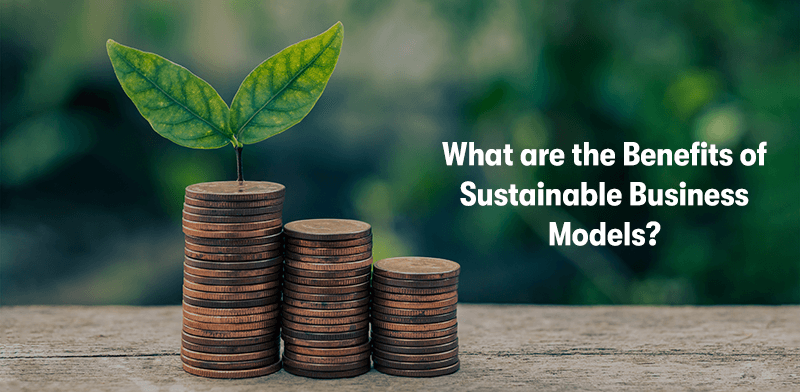
Sustainable business models offer a range of benefits that extend beyond the traditional financial bottom line, encompassing environmental, social, and economic advantages. These benefits can be substantial for the business itself, as well as for society and the environment. Here are some of the key benefits:
Enhanced Brand Image and Reputation
Businesses that demonstrate a commitment to sustainability enjoy a stronger and more positive brand image. This can lead to increased customer loyalty as consumers increasingly seek companies aligning with their environmental responsibility and social equity values.
Cost Savings
Sustainable practices, such as energy efficiency, waste reduction, and sustainable sourcing, can lead to significant cost savings. For example, using less energy or water, minimising waste, and optimising supply chains can reduce operational costs.
Risk Mitigation
Sustainability-oriented businesses are better positioned to anticipate and adapt to environmental, social, and regulatory changes. This proactive approach can help mitigate risks associated with resource scarcity, climate change, and shifting regulatory landscapes.
Increased Innovation and Competitiveness
The focus on sustainability can drive innovation in products, services, and business processes. This can open up new markets and opportunities and help the business stay ahead of competitors who are slower to adopt sustainable practices.
Employee Attraction and Retention
Companies with strong sustainability programs are often more attractive to employees, particularly among younger generations who prioritise environmental and social issues. This can lead to higher employee engagement, satisfaction, and retention levels.
Improved Financial Performance
While the relationship between sustainability and financial performance is complex, there is growing evidence that sustainable businesses can achieve equal or even superior financial performance compared to their less sustainable peers. This can be attributed to factors like operational efficiencies, brand loyalty, and reduced risk.
Positive Social and Environmental Impact
By prioritising sustainability, businesses can have a direct positive impact on the environment and society. This can include reducing greenhouse gas emissions, conserving natural resources, improving the lives of workers in the supply chain, and contributing to the communities in which they operate.
Long-Term Business Viability
Sustainable business models are often more resilient and better equipped for long-term success. By considering the long-term implications of their actions and focusing on enduring sustainability, these businesses are more likely to thrive in a rapidly changing world.
Access to Capital
Investors increasingly consider environmental, social, and governance (ESG) factors in their investment decisions. Sustainable businesses may find it easier to attract investment and funding as they align with the growing focus on responsible investment.
Regulatory Compliance and Advantages
Companies that lead in sustainability are often ahead of regulatory requirements, reducing non-compliance risk. They may benefit from incentives or subsidies for sustainable practices.
In summary, sustainable business models offer a holistic approach that can lead to a wide range of benefits, from cost savings and risk mitigation to improved brand reputation and long-term viability, all while positively impacting the environment and society.
Why Are Sustainable Business Models So Important?

Sustainable business models are increasingly important for several compelling reasons, reflecting the interconnected nature of our global economy, society, and environment. Here are some of the key reasons why these models are crucial:
Addressing Environmental Challenges
With growing concerns about climate change, resource depletion, and environmental degradation, businesses have a critical role in mitigating their environmental impact. Sustainable business models help reduce carbon footprints, conserve natural resources, and protect ecosystems, vital for the planet's health and sustainability.
Social Responsibility and Ethical Considerations
There is a growing expectation for businesses to operate ethically and contribute positively to society. This includes ensuring fair labour practices, promoting diversity and inclusion, and contributing to the communities in which they operate. Sustainable business models align with these ethical considerations by integrating social responsibility into their core operations.
Economic Resilience and Longevity
Sustainable businesses tend to be more resilient in the face of economic challenges. Focusing on long-term sustainability rather than short-term gains makes them better prepared to adapt to market changes, regulatory shifts, and environmental challenges, ensuring long-term economic viability.
Changing Consumer Preferences
There is a noticeable shift in consumer behaviour, with an increasing number of consumers preferring to buy from environmentally and socially responsible companies. Sustainable business models are, therefore, crucial for meeting these changing consumer demands and maintaining competitive advantage.
Regulatory Compliance and Anticipation
Governments and international bodies are implementing stricter regulations on environmental and social issues. Sustainable business models position companies to not only comply with current regulations but also to anticipate and adapt to future legislative changes, avoiding risks of non-compliance.
Attracting and Retaining Talent
Employees, especially among younger generations, are increasingly seeking employers who align with their values of sustainability and social responsibility. Companies with sustainable practices tend to attract and retain talent more effectively, benefiting from a motivated and committed workforce.
Innovation and New Opportunities
Sustainability challenges encourage innovation in products, services, and business processes. This drive for innovation can open up new markets and opportunities, spurring economic growth and development.
Investor Attraction and Financial Performance
Investors are progressively factoring environmental, social, and governance criteria into their investment decisions. Sustainable business practices can attract investment and correlate with strong financial performance and lower investment risk.
Building Trust and Reputation
Companies seen as responsible and sustainable enjoy enhanced trust and reputation with stakeholders, including customers, partners, and the public. This goodwill is a valuable asset in a competitive and interconnected global market.
Global Impact and Leadership
Sustainable businesses can set an example and lead the way in their industries, encouraging others to follow suit. This collective movement towards sustainability is essential for addressing global challenges such as climate change and social inequality.
In summary, sustainable business models are not just a trend but a necessity in today's world. They enable businesses to thrive economically while positively impacting society and the environment, ensuring that they can continue to prosper in a world that increasingly values sustainability.
What Are Examples of a Sustainable Business Model?
Sustainable business models come in various forms, each focusing on different aspects of sustainability while maintaining economic viability. Here are some examples illustrating the diversity and creativity in approaching sustainability in business:
Circular Economy Models
Businesses adopting this model focus on creating a closed-loop system where resources are reused, repaired, refurbished, and recycled for as long as possible. This approach reduces waste and resource consumption. For example, a furniture company that designs products for easy disassembly and refurbishment or a tech firm that recycles and reuses components of old devices.
Product-as-a-Service (PaaS)
Instead of selling products, companies offer them as a service. This encourages the company to produce high-quality, durable products and allows customers to access the latest products without owning them. For example, a car manufacturer offering a car-sharing service or a company leasing high-quality appliances and taking responsibility for their maintenance and eventual recycling.
Green Energy and Low Carbon Models
Businesses in this category focus on renewable energy and low-carbon technologies to reduce greenhouse gas emissions. This can include solar or wind energy firms or traditional companies investing significantly in transitioning their energy sources to renewables.
Social Enterprises
These businesses prioritise social and environmental goals alongside financial profits. They might operate in various sectors, such as fair trade, community development, or environmental conservation, reinvesting a significant portion of their profits into their social mission.
Sustainable Supply Chain Models
Companies focusing on sustainable sourcing and supply chain practices. This includes sourcing materials ethically, ensuring fair labour practices throughout the supply chain, and minimising the environmental impact of logistics and production.
Eco-Labelling and Transparency Models
Businesses that provide complete transparency about their products or services' environmental and social impacts. This can involve eco-labelling, where products are marked with certifications or ratings indicating sustainability.
Regenerative Agriculture
This model focuses on farming practices that regenerate and improve soil health, biodiversity, and water cycles in the food and agriculture sector rather than depleting resources.
Community-Based Models
Businesses that operate in a way that directly benefits local communities, such as community-owned renewable energy projects, local food cooperatives, or businesses that employ and train people from marginalised groups.
Sharing Economy Models
These models leverage technology to facilitate sharing goods, services, and resources. This can range from ride-sharing and accommodation-sharing platforms to tool and equipment lending services.
Impact Investing and Sustainable Finance
Financial services companies focus on investments that generate social and environmental impact alongside financial returns. This includes green bonds, sustainable investment funds, and microfinance services aimed at underserved communities.
These examples show the breadth and adaptability of sustainable business models across different industries and sectors. They demonstrate how businesses can innovate and evolve to meet both the demands of a growing economy and the pressing need for sustainability.
How Can You Build a Sustainable Business Model for Your Company?
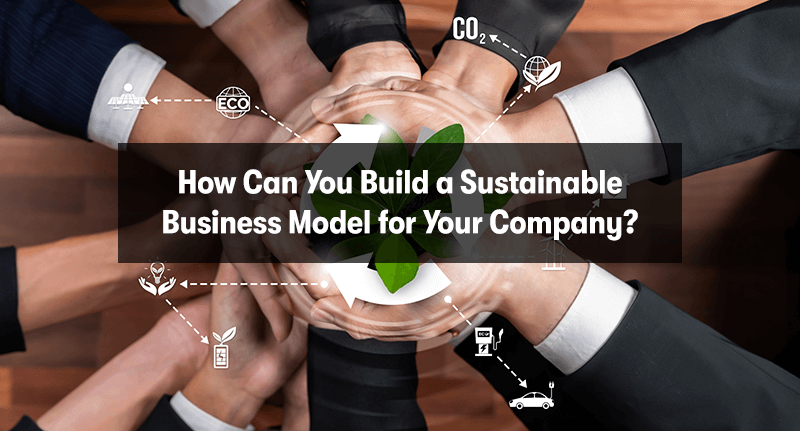
Building a sustainable business model involves integrating sustainability into the core of your business strategy and operations. It's a process that requires commitment, innovation, and often a shift in how a business traditionally operates. Here are steps and considerations to guide you in developing a sustainable business model for your company:
Understand and Commit to Sustainability Principles
Start by understanding the three pillars of sustainability: environmental protection, social equity, and economic viability.
Commit at the highest levels of leadership to embed sustainability into your company's mission and values.
Conduct a Sustainability Audit
Assess your current business practices to identify areas where you can improve sustainability. This includes evaluating your environmental impact, labour practices, supply chain, and community engagement.
Set Clear and Achievable Sustainability Goals
Based on your audit, set specific, measurable, achievable, relevant, and time-bound (SMART) goals for sustainability.
Goals could range from reducing carbon emissions and waste to improving employee well-being and community engagement.
Develop a Strategy and Plan
Create a comprehensive plan that outlines how you will achieve your sustainability goals. This should include both short-term initiatives and a long-term vision.
Ensure your plan is flexible and adaptable to changes in the business environment.
Engage Stakeholders
Involve employees, customers, suppliers, and other stakeholders in your sustainability efforts.
Communication and transparency are key. Share your sustainability goals and progress with stakeholders.
Innovate and Redesign
Innovate your products, services, and processes to be more sustainable. This could include redesigning products for durability and recyclability, shifting to renewable energy sources, or implementing more efficient strategies.
Focus on the Supply Chain
Work with suppliers to ensure they also follow sustainable practices. Consider the entire lifecycle of your products, from raw materials to end-of-life.
Implement and Monitor
Implement your sustainability initiatives and regularly monitor your progress. Use metrics and indicators to track how well you are meeting your goals.
Be prepared to adjust your strategy as needed.
Foster a Sustainable Culture
Encourage a culture of sustainability within your organisation. Educate and train employees about the importance of sustainability and how they can contribute.
Recognise and reward sustainable practices among your employees.
Report and Communicate
Regularly report on your sustainability performance, both internally and externally.
Use sustainability reporting as a tool to engage with your stakeholders and enhance your company's transparency.
Comply and Go Beyond Compliance
Ensure compliance with all relevant environmental and social regulations.
Aim to exceed minimum standards, positioning yourself as a leader in sustainability.
Seek Partnerships and Collaboration
Collaborate with other businesses, non-profits, and government agencies on sustainability initiatives.
Partnerships can provide new insights, resources, and increased impact.
Remember, transitioning to a sustainable business model is a journey that doesn't happen overnight. It requires ongoing commitment and willingness to evolve. Each step forward contributes to a more sustainable future for your business and the wider community.
What Makes a Sustainable Business Model Work?
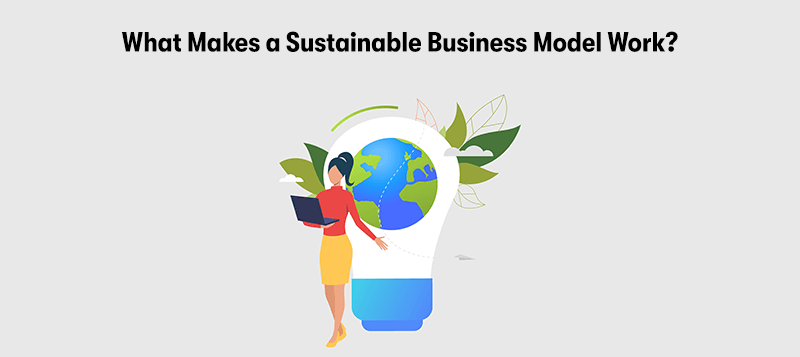
For a sustainable business model to work effectively, it needs to incorporate several key elements and principles. These elements ensure that the model is both environmentally and socially responsible and economically viable and resilient in the long term. Here are the essential factors that make a sustainable business model successful:
Alignment with Core Business Strategy
Sustainability should be integrated into the core business strategy, not just an add-on or a compliance issue. This alignment ensures that sustainability efforts support and enhance the company's overall goals and objectives.
Leadership Commitment and Governance
Effective, sustainable models are driven by strong leadership commitment. Leaders must actively promote and implement sustainability initiatives, and governance structures should support sustainability goals.
Stakeholder Engagement and Transparency
Engaging with stakeholders (including employees, customers, suppliers, and the community) is crucial. Understanding their needs and expectations can guide sustainability efforts, and transparent communication about goals, progress, and challenges builds trust and credibility.
Innovation and Adaptation
A sustainable business model often requires innovative thinking in product design, service delivery, and operational processes. The ability to adapt to changing market demands, technological advancements, and environmental conditions is critical.
Economic Viability
While focusing on environmental and social goals, the business model must also be economically sustainable. It should generate enough revenue to cover costs, invest in sustainable practices, and provide returns to stakeholders.
Measurable Impact and Continuous Improvement
The effectiveness of sustainability initiatives should be measured using clear metrics. Continuous improvement based on these metrics allows businesses to track progress and make necessary adjustments.
Balanced Approach to Triple Bottom Line
A sustainable business model balances the triple bottom line – people, planet, and profit. This balance ensures that financial goals and vice versa do not overshadow environmental and social responsibilities.
Risk Management and Resilience
Understanding and managing environmental and social risks is a key component. A sustainable business model enhances the company's resilience to external shocks, including economic downturns and environmental crises.
Regulatory Compliance and Beyond
Compliance with environmental, social, and governance regulations is a baseline. Sustainable businesses often set their internal standards higher than regulatory requirements.
Corporate Culture and Employee Engagement
Embedding sustainability into the corporate culture and engaging employees at all levels in sustainability practices ensures that these efforts are widespread and sustained over time.
Long-Term Perspective
Sustainable business models require a long-term perspective, focusing on future impacts and sustainability over generations, not just immediate results.
Collaborative Approach
Collaboration with other businesses, non-profits, governments, and communities can lead to more significant impacts and shared learning. This collaborative approach often leads to innovative solutions to complex sustainability challenges.
In summary, a sustainable business model integrates sustainability into every aspect of the business, from strategy and leadership to operations and culture. It requires a holistic approach, balancing economic success with environmental stewardship and social responsibility, and is underpinned by innovation, adaptability, and a long-term perspective.
What is Digital Sustainability?
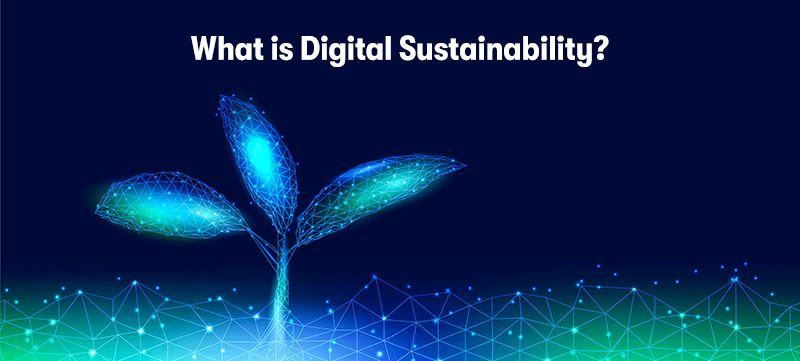
Digital sustainability refers to designing, implementing, and using digital technologies to support and enhance an organisation's or society's overall sustainability. It encompasses a broad range of considerations, from the environmental impact of technology infrastructure to the way digital tools are used to promote social and economic sustainability. Here are some key aspects of digital sustainability:
Energy Efficiency of Digital Technologies
One of the primary concerns in digital sustainability is the energy consumption of digital infrastructure, such as data centres, network systems, and devices. This includes efforts to use energy more efficiently and to shift towards renewable energy sources for powering these technologies.
Reducing E-Waste
The production and disposal of electronic devices contribute significantly to global e-waste. Digital sustainability involves designing products for longer lifespans, promoting repair and reuse, and ensuring proper recycling of electronic components.
Sustainable Software Design
This refers to creating efficient software for resource usage, such as minimising the energy required for computing operations and data storage.
Access and Inclusivity
Digital sustainability also encompasses ensuring equitable access to technology, addressing the digital divide, and using digital tools to promote social inclusion and accessibility.
Responsible Data Management
This includes managing data in a way that respects privacy and security, reduces the carbon footprint associated with data storage and processing, and uses data to support sustainable outcomes.
Promoting Sustainable Behaviours
Digital technologies can encourage and facilitate sustainable behaviours in other areas, such as through apps that promote sustainable transportation, energy use, or consumption habits.
Sustainable Business Models
In a business context, digital sustainability might involve using digital tools to support sustainable business practices, like remote working to reduce travel-related carbon emissions or using digital collaboration tools to reduce the need for physical resources.
Lifecycle Analysis
Considering the entire lifecycle of digital technologies, from resource extraction for manufacturing to end-of-life disposal, and seeking to minimise the environmental footprint throughout this lifecycle.
Policy and Governance
Establishing policies and governance structures that promote the sustainable use of digital technologies within organisations and at broader societal levels.
Innovation for Sustainability
Leveraging digital innovation to address environmental challenges, such as using big data and AI for climate modelling or developing digital platforms for circular economy initiatives.
Digital sustainability is an evolving field, reflecting the growing recognition of digital technologies' environmental and social impacts and the potential for these technologies to contribute positively to sustainable development goals.
Where Can You Learn More About Digital Sustainability?
At Purple Griffon, we offer an ITIL® 4 Specialist Sustainability in Digital & IT (SDIT) training course. This course will help you to:
- Understand how to use the ITIL guiding principles to deliver value by creating sustainable digitally enabled products and services.
- Effectively address VUCA challenges through sustainable strategies, procurement, products and practices.
- Obtain a practical grounding in the key principles of sustainability.
- Conduct a complete cost-benefit analysis identifying potential risks and opportunities using best practice guidance.
Final Notes on Sustainable Business Models
As we conclude our exploration of sustainable business models and digital sustainability, it's evident that integrating environmental, social, and economic considerations is beneficial and essential for businesses' long-term success and viability. From adopting circular economy principles and promoting energy efficiency in digital technologies to fostering a culture of innovation and stakeholder engagement, sustainable practices are reshaping how businesses operate in the 21st century.
Embracing digital sustainability also plays a crucial role, highlighting the importance of responsible digital practices in achieving broader sustainability goals. As we move forward, it's clear that the commitment to sustainability is a journey of continuous improvement, driving businesses towards a future that is not only profitable but also responsible and resilient.
Let's embrace this transformative journey for a sustainable tomorrow.


